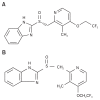Pharmacological and Safety Profile of Dexlansoprazole: A New Proton Pump Inhibitor - Implications for Treatment of Gastroesophageal Reflux Disease in the Asia Pacific Region
- PMID: 26932927
- PMCID: PMC4930293
- DOI: 10.5056/jnm15150
Pharmacological and Safety Profile of Dexlansoprazole: A New Proton Pump Inhibitor - Implications for Treatment of Gastroesophageal Reflux Disease in the Asia Pacific Region
Abstract
Although gastroesophageal reflux disease is not as common in Asia as in western countries, the prevalence has increased substantially during the past decade. Gastroesophageal reflux disease is associated with considerable reductions in subjective well-being and work productivity, as well as increased healthcare use. Proton pump inhibitors (PPIs) are currently the most effective treatment for gastroesophageal reflux disease. However, there are limitations associated with these drugs in terms of partial and non-response. Dexlansoprazole is the first PPI with a dual delayed release formulation designed to provide 2 separate releases of medication to extend the duration of effective plasma drug concentration. Dexlansoprazole has been shown to be effective for healing of erosive esophagitis, and to improve subjective well-being by controlling 24-hour symptoms. Dexlansoprazole has also been shown to achieve good plasma concentration regardless of administration with food, providing flexible dosing. Studies in healthy volunteers showed no clinically important effects on exposure to the active metabolite of clopidogrel or clopidogrel-induced platelet inhibition, with no dose adjustment of clopidogrel necessary when coprescribed. This review discusses the role of the new generation PPI, dexlansoprazole, in the treatment of gastroesophageal reflux disease in Asia.
Keywords: Asia; Delayed-action preparations; Dexlansoprazole; Gastroesophageal reflux; Proton pump inhibitors.
Figures





Similar articles
-
The role of dexlansoprazole modified-release in the management of gastroesophageal reflux disease.Therap Adv Gastroenterol. 2017 Feb;10(2):243-251. doi: 10.1177/1756283X16681701. Epub 2017 Jan 5. Therap Adv Gastroenterol. 2017. PMID: 28203282 Free PMC article. Review.
-
Proton pump inhibitors for the treatment of patients with erosive esophagitis and gastroesophageal reflux disease: current evidence and safety of dexlansoprazole.Clin Exp Gastroenterol. 2016 Jul 13;9:163-72. doi: 10.2147/CEG.S91602. eCollection 2016. Clin Exp Gastroenterol. 2016. PMID: 27471402 Free PMC article. Review.
-
Dexlansoprazole: delayed-release orally disintegrating tablets for the treatment of heartburn associated with non-erosive gastroesophageal reflux disease and the maintenance of erosive esophagitis.Expert Rev Gastroenterol Hepatol. 2016 Oct;10(10):1083-1089. doi: 10.1080/17474124.2016.1230496. Expert Rev Gastroenterol Hepatol. 2016. PMID: 27580358
-
Managing gastroesophageal reflux disease - comparative efficacy and outcomes of dexlansoprazole MR.Ther Clin Risk Manag. 2015 Oct 30;11:1649-56. doi: 10.2147/TCRM.S66680. eCollection 2015. Ther Clin Risk Manag. 2015. PMID: 26586949 Free PMC article. Review.
-
Dexlansoprazole in the treatment of esophagitis and gastroesophageal reflux disease.Ann Pharmacother. 2010 May;44(5):871-7. doi: 10.1345/aph.1M685. Epub 2010 Apr 6. Ann Pharmacother. 2010. PMID: 20371754 Review.
Cited by
-
Pantoprazole Does Not Reduce the Antiplatelet Effect of Clopidogrel: A Randomized Controlled Trial in Korea.Gut Liver. 2017 Jul 15;11(4):504-511. doi: 10.5009/gnl16352. Gut Liver. 2017. PMID: 28395507 Free PMC article. Clinical Trial.
-
Phase 4 Study in Patients From Asia With Gastroesophageal Reflux Disease Treated With Dexlansoprazole.J Neurogastroenterol Motil. 2020 Jan 30;26(1):85-95. doi: 10.5056/jnm19031. J Neurogastroenterol Motil. 2020. PMID: 31597230 Free PMC article.
-
Advantages and Disadvantages of Long-term Proton Pump Inhibitor Use.J Neurogastroenterol Motil. 2018 Apr 30;24(2):182-196. doi: 10.5056/jnm18001. J Neurogastroenterol Motil. 2018. PMID: 29605975 Free PMC article. Review.
-
A Comprehensive Review of Xanthan Gum-Based Oral Drug Delivery Systems.Int J Mol Sci. 2024 Sep 21;25(18):10143. doi: 10.3390/ijms251810143. Int J Mol Sci. 2024. PMID: 39337626 Free PMC article. Review.
-
Comparing Efficacy and Safety of Empirical vs. Guided Therapy for Non-cardiac Chest Pain: A Pragmatic Randomized Trial.Front Med (Lausanne). 2021 Feb 15;8:605647. doi: 10.3389/fmed.2021.605647. eCollection 2021. Front Med (Lausanne). 2021. PMID: 33659261 Free PMC article.
References
Publication types
LinkOut - more resources
Full Text Sources
Other Literature Sources
Miscellaneous

